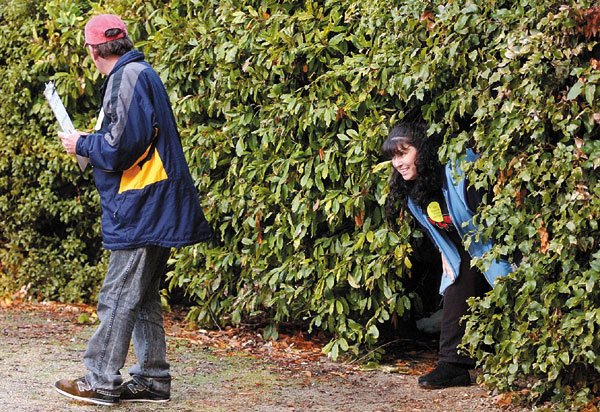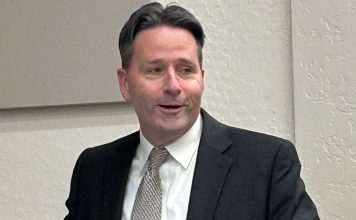Gilroy
– Rain Taylor squints out from her wheezing sedan, out at the
dim alley where two figures shuffle, slight as shadows, in the
rain. She squints, then announces,
”
Homeless.
”
In the backseat, her friend Michael Shepard marks two
tallies.
Gilroy – Rain Taylor squints out from her wheezing sedan, out at the dim alley where two figures shuffle, slight as shadows, in the rain. She squints, then announces, “Homeless.” In the backseat, her friend Michael Shepard marks two tallies.
Taylor tries not to assume. After all, she said, nobody thinks she’s homeless: a sharp-witted white woman with computer savvy and a daughter in college, who laughs easily and reels off tales about troubleshooting laser shows for Pink Floyd, back in the day. When Rain Taylor walks into a store, she is greeted as a valued customer, not a nuisance. When she walks into a shelter, she’s asked why she’s there.
“You can’t tell by looking,” she says. “You have no idea.”
Until recently, county governments had no idea, either. Nobody knew how many men, women and children bedded down on the streets. Shelters kept count, but those in alleys, cars and dry creeks went unnumbered. In Gilroy, those who fed and sheltered the homeless said the city’s homelessness rate was sky-high. But without a count, no one could say for sure.
Now, says South County Collaborative chairwoman Dina Campeau, “we can quantify it. It gives us a real sense of the need.”
In 2004, the Interagency Council on Homelessness saddled cash to an accurate count of the county’s homeless, the starting point for its 10-Year Plan to End Chronic Homelessness. For $168,000, Santa Clara County enlisted Applied Survey Research, a Watsonville company, to tally the people sleeping in shelter beds and river beds, breaking the county into census tracts. In turn, ASR enlisted the experts: homeless people themselves. Pairing the homeless with volunteers, ASR sent them out before daybreak, armed with clipboards and maps, and aided by volunteers with cars. When they returned, bearing tallied sheets, the homeless were paid $50 to $75 each.
“The counties with the most accurate counts get priority,” explained research analyst Tracy Keenan, as she shuffled papers from just-returned volunteers. Every year, counties apply for the McKinney-Vento Grant from the Department of Housing and Urban Development, said county homeless coordinator Sister Margaret Gregg; HUD scores the accuracy of the count. A precise count is a considerable feat, Keenan added, when counting people who, more often than not, try to stay unnoticed.
In 2005, the numbers volunteers tallied stunned county officials, even those who work with the homeless. The 2005 count turned up 7,646 homeless people countywide, 420 of them in Gilroy – more than in cities twice and even triple Gilroy’s size. One-third of those surveyed were chronically homeless, lacking shelter for more than a year, or more than four times in less than three years.
Tuesday, the county completed its second count, required to keep federal dollars flowing toward county homeless services. In a crowded Senior Center meeting room Monday morning – early morning – volunteers choked down coffee and scarfed donuts before taking to the streets. The count occurs before daybreak, before shelters send the homeless back onto the streets, to avoid double-counting those tallied in shelter beds. Addressing a groggy 4am crowd, Keenan offered tips on counting tents, cars and encampments.
“We have a handle on how many are in the shelters,” said Gregg. “It’s the street population that’s harder to track.”
But as Taylor’s car creeps along darkened streets, raindrops sequining its windows, it’s clear that she and Shepard already know where to look. They pass Pinocchio’s Pizza on Monterey Highway, “where Rob brings his RV,” says Taylor; they round the McDonald’s, prized by the homeless for its public bathrooms and nearby bus stop. A laundry’s awning gives shelter. The library is a safe haven.
Taylor has been homeless four weeks; Shepard, slightly longer. They met at the Gilroy Armory, and became fast friends, linked by painful pasts. Shepard lost a wife and daughter to one drunk driver; Taylor nearly lost her life to another, who left her with a broken pelvis, five ruptured discs, a dislocated jaw and a shattered knee. She hasn’t worked since the accident last year, and drained her retirement account waiting for a legal settlement that hasn’t delivered.
“I lost my house, my old car, my business and my marriage fell apart,” she recounted, driving alongside a darkened Christmas Hill Park. “Even now, I get panic attacks. Night tremors.”
Shepard listens quietly from the backseat. For Taylor, there’s a measure of protection in having a male friend. At the armory in Sunnyvale, she said, a shelter employee eyed her “like I’m a steak dinner, and he hasn’t eaten in a week.” In Gilroy’s armory, she said she’s been discouraged from dancing when she listens to music, lest she provokes the men. According to the 2005 survey, about 27 percent of the county’s homeless are adult women.
“It’s very rare to find a homeless single woman,” said Campeau. “They’ll pair up with a man for protection.”
That, in turn, leaves many vulnerable to abuse and domination. Shepard is one of the good guys, Taylor said, but he’s gotten harassed by other homeless men, who goad him and invite Taylor to share their sleeping quarters.
“You learn where to look for shelters, showers, food,” said Taylor. “You develop instincts.”
County-wide, the two-day count ended Tuesday. New numbers won’t be available until April, when ASR releases a new survey and report on the county’s homeless. Gregg said she’s curious to see if the numbers have changed, but few believe the stats will result in increased funding. Though federal funders require the count for grants, cash for homeless programs remains scarce. The highly-anticipated 10-Year Plan, aimed at ending long-term homelessness for good, is still largely aspirational.
“Most of the initiatives are grossly underfunded,” said Jeff Fishback, employment services director at St. Joseph’s Family Center, “and – I hate to say it – but therefore unachievable.”
As dawn breaks, Taylor and Shepard scan the few remaining streets in their census tract. At Miller Park, they encounter Chris Salazar, who they’ve met before at the Armory. The night was frigid and rainy, but Salazar chose to lodge in a park restroom, instead of a shelter bed. He didn’t want to feel “locked down.”
“I go on these drinking binges sometimes,” Salazar adds. “If you do that, you’re outta there.”
Unlike Taylor, Salazar fits the stereotypes of who’s homeless. In many ways, he matches the county’s typical homeless profile, as detailed by the 2005 survey: a forty-something man grappling with addiction. In other ways, he defies it. Salazar holds two jobs, he said, and he’s learning to be a loan officer.
Which shows why this year’s count, and the accompanying survey, are still needed.
“People think we’re all alcoholics or addicts. They think we don’t work,” said Shepard. “But nobody bothers to ask.”














